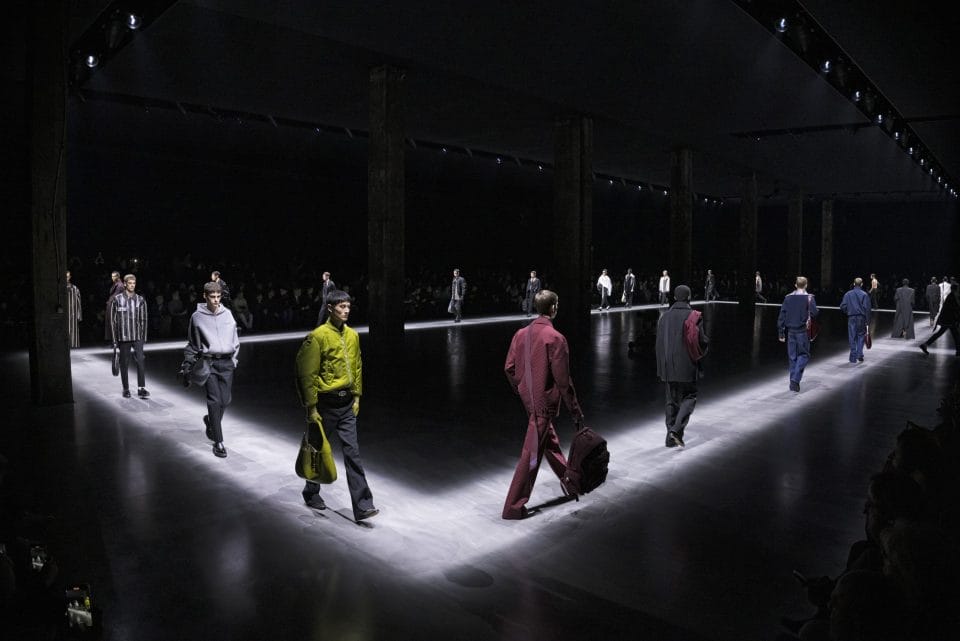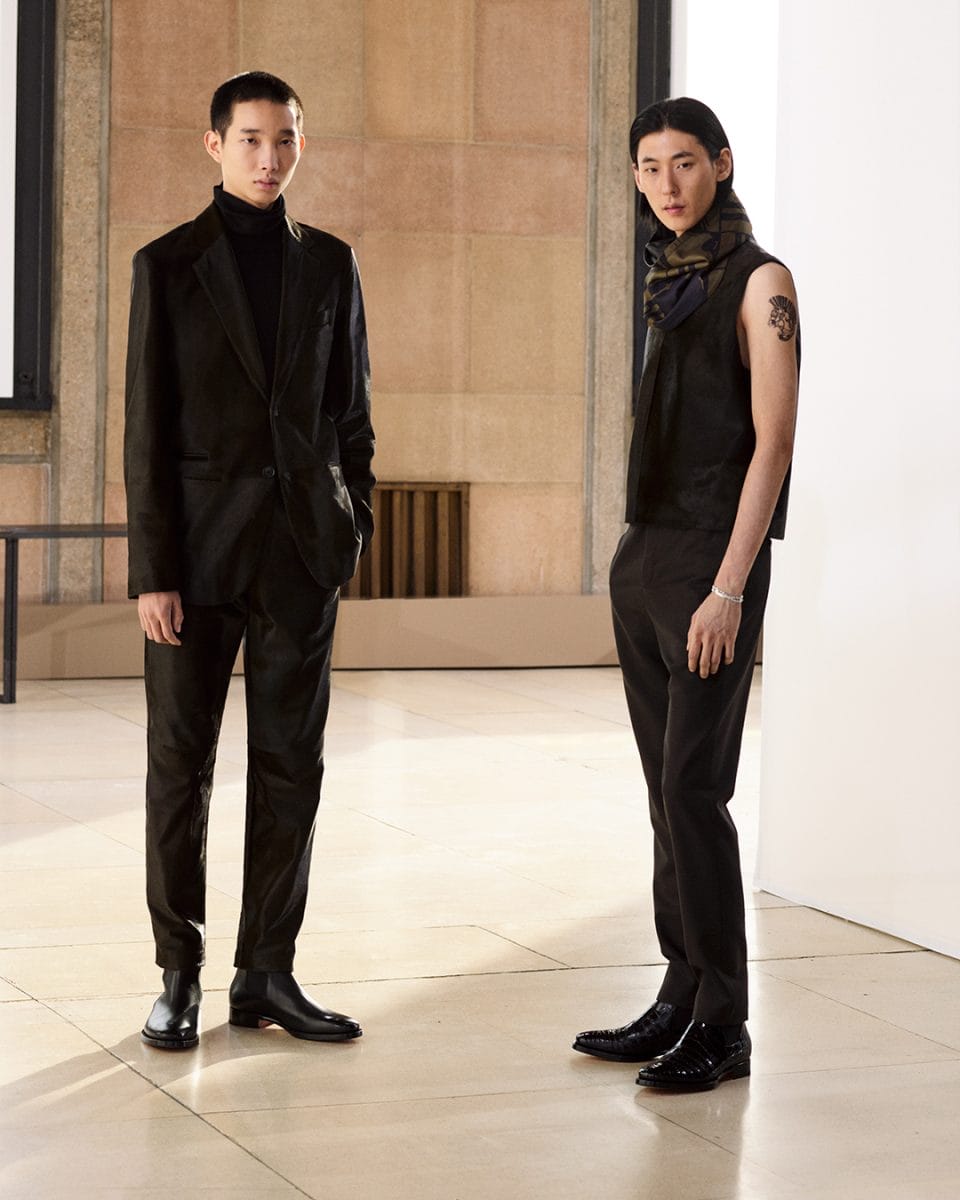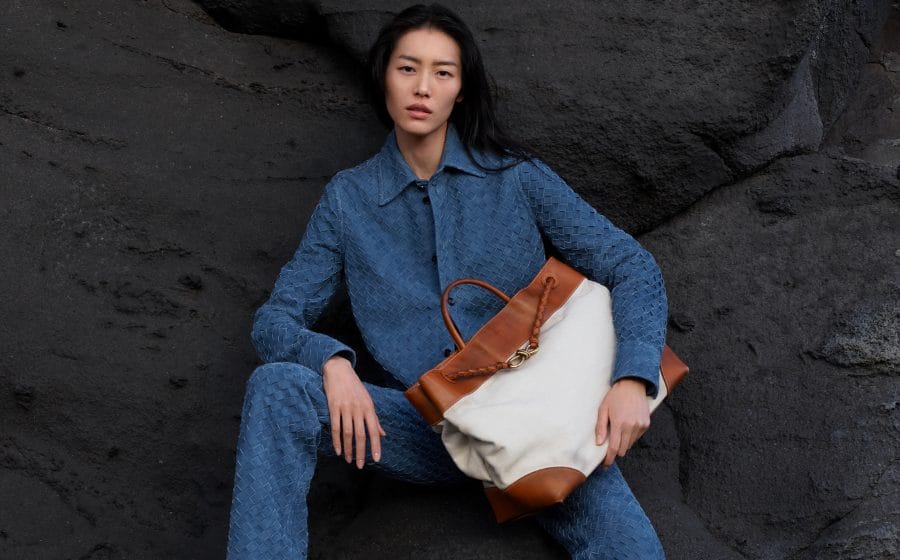 What can the soundtrack of a fashion show say about the state of fashion, culture and the way we negotiate the movement of music through time? With an observed rise in the use of indie music during the Fall Winter 2024 collections, Men’s Folio does some research.
What can the soundtrack of a fashion show say about the state of fashion, culture and the way we negotiate the movement of music through time? With an observed rise in the use of indie music during the Fall Winter 2024 collections, Men’s Folio does some research.
Music — with or without words — is a ubiquitous companion to our everyday lives that speaks to our very essence. Nowhere is this truth more evident than on the fashion runways, where music wields and imparts emotions to creative directors and spectators alike. Each delivery dynamic and one of a kind, in a fusion of different styles and genres where atmospheric soundscapes permeate the fashion arena.
While music and fashion are inextricably linked in how each inspires and enriches the other in subtle yet profound ways, they never form a balanced dynamic. Sometimes, music is used as a mere accompaniment; other times, it takes centre stage to create immersive experiences.
As we did our due diligence of making critical observations during the most recent Menswear Fall Winter 2024 collections, the discovery of a common sonic thread highlighted a need to examine the symbiotic relationship between music and fashion. Familiar to certain folk who once savoured the quiet within the loud and the beautiful chaos in monotony, the runways were either playing tracks by artists that were at their peak in the early naughts, or playing tracks that had that distinctly nonchalant indie colour.
It would be easy to sign this off as a symptom of the industry’s fascination with certain visual codes from that time, but the creative gears that make fashion work would not permit such a simple dismissal. So, if this is no surface-level collaboration, what is it and what does this mean? Is the indie sleaze back for real?
A New Age
Gucci’s Men’s Fall Winter 2024 show is one of the main reasons why this indie sonic thread began to extend its reach and has one of the strongest cases for this argument because the music is employed in both the men’s and women’s collections and thus, doubly significant.
Mark Ronson — the music director of the show — crafted a custom soundtrack for Sabato De Sarno’s debut by remixing Italian singer Mina’s “Ancora, ancora, ancora” with Romy Madley Croft’s “Loveher” and Lykke Li’s “Late Night Feelings.” What is birthed is a minimalist atmosphere that exudes emotional depth. The unending loop of Romy singing I love her is akin to De Sarno penning a love letter to the brand.
Yet, what is crucial here is who Romy is and what her presence brings to this new Gucci story. Romy is part of The xx — an English indie rock band that came out during a period of poptimism and maximalist aesthetics after the 2008 Financial Crisis — trailblazing the alternative flavour of minimalism in that era through their music. Permeating through cultural spheres — now in the 2020s — Romy represents a similar debut-focused aesthetic of De Sarno’s collection, echoing the simple yet seismic shift that the creative director has enacted on the silhouettes, fabrications and overall look of Gucci post-Alessandro Michele — just as The xx did with music in the 2000s.
Space For Interpretation

Then there are the more sophisticated readings about what this genre of music can do for and to fashion shows, because of its elusiveness. Hermès, whose collection — although steeped in tradition and renowned for its unmatched craftsmanship — used Paul Sylvan’s post-punk anthem “Cool Girls” for its Fall Winter 2024 collection. With a music video of Sylvan shredding a guitar while wearing vintage dresses, this mid-tempo, muted dance track and artist starkly contrasts everything Hermès is known for.
Further research reveals how the Englishness of the equestrian palette somewhat complements the infinite, droning sound of the track and electronic music’s roots, signalling perhaps a desire to inject a ruckus and youthful energy into their lexicon from a safe distance. In this instance, relationships and contacts are made through association and cultural context, never direct and explicit and are open to interpretation.
At Sacai, Chitose Abe’s Fall Winter 2024 collection explored the concept of uniform alongside the unlikely companion of chess — not the game itself — but within the artiste Actress’ latest album, LXXXVII. Featuring minimal techno — a hallmark of Actress’ sound — the tracks “Push Power ( a 1 )” and “Typewriter World ( c 8 )” create an off-kilter sound design that matches the sound symbolism of the word “strategy” — calculated and swift — as if the models were players embodying Abe’s unified aesthetic. Actress’ track titles each contain a coordinate on the chessboard; this is perhaps Abe’s way of getting us to reconsider uniformity as a deliberate choice of intention and purpose instead of the lack of — and in doing so, allowing new meaning to be derived from the mere hybridisation of form. Again, indie music is tasked with a specific purpose, and these two cases show the value of the minimal and its space for considered contemplation.
Attract Through Abstraction
Up till now, the relationship between the collections and the choice of soundtracks is discernible and logical in terms of purpose. But a big part of why the adoration of minimal sound arrangements and unconventional melodies were titled “alternative” was because they were not made to be conventionally “attractive”. In this abstract nature, indie music endeared the hedonistic release that matched a time of one’s life when messy was a norm.
View this post on Instagram
At Sankuanz, the Fall Winter 2024 collection’s homage to traditional Chinese attire and classic tailoring archetypes was accompanied by “Seven Diamond Lines”, a track by Chinese musical artist Tadi Yan. Laden with the sacred chants of Buddhist texts, this audio odyssey transports listeners to the summit of the mountain. The beat adds to the listening experience like an electronic one would — the sense of an expanding infinite or unendingness that recalls the droning quality of electronic dance music.
 This abstract aesthetic of music is taken to another level at Loewe. Here, pop is quite literally subverted. The Fall Winter 2024 collection’s techno soundtrack blasted everything from Nirvana’s “The Man Who Sold the World”, to the Western orchestrations of Ennio Morricone and Spoek Mathambo’s pulsating “Control”, all interspersed with snippets of Sean Penn and Justin Bieber interviews. Jonathan Anderson stated that the collection was a commentary on the pervasiveness of the Internet, the one-ness of today’s human experience. But the effect was almost comical, with the absurdity of hearing all these unrelated noises stringing together a sonic backing that gave Anderson’s collection the colour needed to bring out brilliant quirk and individuality.
This abstract aesthetic of music is taken to another level at Loewe. Here, pop is quite literally subverted. The Fall Winter 2024 collection’s techno soundtrack blasted everything from Nirvana’s “The Man Who Sold the World”, to the Western orchestrations of Ennio Morricone and Spoek Mathambo’s pulsating “Control”, all interspersed with snippets of Sean Penn and Justin Bieber interviews. Jonathan Anderson stated that the collection was a commentary on the pervasiveness of the Internet, the one-ness of today’s human experience. But the effect was almost comical, with the absurdity of hearing all these unrelated noises stringing together a sonic backing that gave Anderson’s collection the colour needed to bring out brilliant quirk and individuality.
IYKYK
As much as we can read into the way the indie and alternative dance tracks give more value to the way we appreciate the fashion they accompany, Jonathan Anderson was spot on with nailing our research question on the head. The one common trait all these pairings have is the way they are empowered by referentiality — or the “IYKYK” (if you know, you know) quality — and perhaps this pandemic-enhanced nostalgia for the freedom of life before is why we hear indie tracks on the runways.
Maybe it is only accurate to coin nostalgia for the millennials who truly lived through those times. To the Gen Zs who have only seen and heard glimpses of it floating around the time capsule that is the Internet, it is indie sleaze — a novel era that was okay with any and everything, where uncool was cool. That is the nostalgia they cannot have, that era-defining indulgence and excess more of a privilege than a choice for the current youth that feels robbed of what society deems as, well, “youth”.
This obsession with the early Internet era is also perhaps an inescapable phenomenon that comes from an over-connected and stifling life lived perpetually online. Perhaps indie sounds on the runway are a response to this desire — to connect IRL instead of via URL. Within this revival is the subtle subversion that fashion and its sound will see a rise against quiet luxury — just like how it is a response to the ostentatious luxury that arose in the 2010s economy.
Once you are done with this story, click here to catch up with our April 2024 issue.







